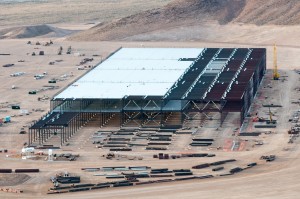But just not widespread — yet. The Washington Post discusses the small but growing group of people who are going off-grid entirely with the help of batteries for their solar power. And as battery prices decrease, this trend will only grow, in part thanks to Tesla’s big push in this space:
Batteries already help power homes in places where energy grids are spotty, on islands and in developing countries including India and Bangladesh. But they have remained a niche for homeowners in the U.S., even as more and more demanding connections on America’s aging power grid have pushed power outages up 285 percent since 1984.
Tesla, with its corporate star power, has quickly become the home-battery industry’s best-known cheerleader, and its boosterism could give home batteries their best shot at finding acceptance in mainstream America.
Notably, the only people for now who buy batteries for backup power seem to be those who are concerned about blackouts, want new technology, and have the money to afford it. So it will be important for policy makers to encourage these purchases through better electricity rate design that rewards rooftop solar and other battery customers who can store and discharge power when the grid needs it.
The New York Times ran an excellent piece over the weekend on the challenges in Hawaii to adding more rooftop solar. Hawaii’s investor-owned utility has been restricting new access to rooftop solar compensation for the last 18 months. Utility spokespeople claim it’s due to the high volume of solar rooftops in the state, which leads the nation. They say it’s creating operational expenses and reliability challenges. But the reality is that utility leaders simply don’t want to lose revenue from more distributed solar.
As the article points out, Hawaii is presenting a glimpse of our future across the U.S., as solar panels become cheaper and electricity rates increase. But I was struck by one part of the story, detailing how some customers are reacting to these restrictive policies:
Installers — who saw their fast-growing businesses slow to a trickle — are also frustrated with the pace. For those who can afford it, said James Whitcomb, chief executive of Haleakala Solar, which he started in 1977, the answer may lie in a more radical solution: Avoid the utility and its grid altogether.
Customers are increasingly asking about the batteries that he often puts in along with the solar panels, allowing them to store the power they generate during the day for use at night. It is more expensive, but it breaks consumer reliance on the utility’s network of power lines.
“I’ve actually taken people right off the grid,” he said, including a couple who got tired of waiting for Hawaiian Electric to approve their solar system and expressed no interest in returning to utility service. “The lumbering big utilities that are so used to taking three months to study this and then six months to do that — what they don’t understand is that things are moving at the speed of business. Like with digital photography — this is inevitable.”
This is called “grid defection,” or going off the utility grid entirely. And if battery prices keep decreasing, electricity rates keep increasing, and utilities keep pushing back against solar customers, we may start seeing a whole lot more of it. And all three of these trends are happening across the United States right now.



